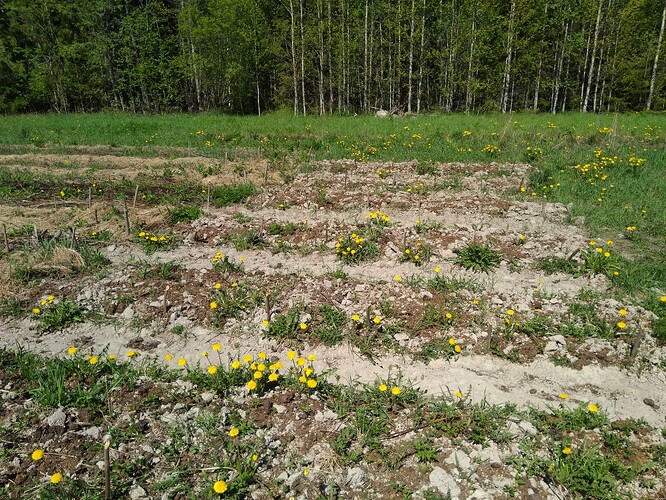The rains continued after the last visit. Nothing too heavy, but together with what I mentioned last time it has rained around 50mm this month. Looks like it will rain some more every few days, but temperatures also stay good for growth with highs of 20-25C (68-77F). Especially nights are warmer than average because of partially overcast weather. Even ground level it will remain above 10C (50F) and nights are very short this time of the year.
I was expecting to see more growth, but it looks like once you compare pictures, there has been quite good growth overall. Favas and potatoes were the most obvious even without comparing pictures. Dispite the rains, it still looks quite dry. Total is still well below average since may on top of several dry years, which might mean that it need a lot to recuberate. There are also lot’s of water vole holes and I don’t know if that could have something to do with it. I knew it wasn’t the best place to put a garden and we’ll have to see if it will improve over the years. At the moment goal has been lowered to making seeds that are adabted for the next year.
Sweet corn and maximas are partially doing good. Looks like I’ll get some seeds.
One was culled after previous update, but these 2 can both stay as they are from different seeds and there is plenty of space on other sides.
The best summer squash aren’t showing sings of stress whatsoever. They are little later than if I had cared for them, but all things considered they look impressive. These 4 plants are from the same seeds and right over the line that marks different seeds, the plants don’t look as fresh. All plants have little differences which makes me think it’s F2 and probably one with arabian squash in it.
There are even the first female showing. i’m not sure if it’s ideal for plant this small to produce fruit for seed (possibly big fruit), but I don’t think I have a lot of time to be picky. If it get’s pollinated and starts growing, it probably can stay. Another matter if it will get pollinated. There are males showing, but I likely won’t be there to make sure of the pollination.
Some of the more struggling summer squashes. Some show positive signs and some are at least getting ready to be pollen donors with males already showing.
Cucumbers have atleast a couple of better plants. Some are ok atleast for donating pollen to get some diversity. But the clock is ticking for the fruits to form.
Moschata are still looking quite yellow, but there has been some growth with the first starting to vine. Still not sure if they will make fruits in time, but at least male flowers are showing. They should bloom early enough to impliment my back-up plan.
Favas probably had some 20cm growth since the last update.
Just dug out runner beans from under the weeds. They are quite sorry looking, but still well in time. Need to finish trellising as they start to vine.
This is what I have to deal with. I could fit my hand in. No wonder if at some places plants aren’t doing that great although I’m not sure if these explain wide areas of poor growth, but rather single plants. I have been meaning to get these devices that should scare voles with sound/vibration. Might also keep the deer away. They haven’t eaten anything, but might tramble on plants. According to person who has farmed the field for several years, they have never eaten anything from them. Just using the nearby field to sleep at night.






























































